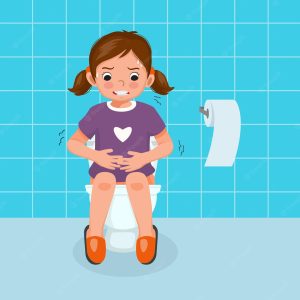Childworks Occupational Therapy – Toilet Blog Series – Part 3
Here’s our third instalment of Rimjhim’s Toileting Blog Series. This Blog focuses on a somewhat less appealing complication of toileting that we all experience from time to time – constipation. In children, especially those with disorders, this can be an extremely problematic condition of toilet training. Rimjhim provides an excellent resource on how to alleviate some of the symptoms.
Healthy poos and when to ask for help
Healthy poos and wees and when to ask for help! So far we have discussed all the skills a child needs to become independent with toileting and the best way to sit. Today’s blog focusses on constipation and the importance of staying hydrated. I have also included some signs that a child is struggling with the toilet training process and may need more support.
 Constipation is a commonly overlooked difficulty that can complicate the toilet training process. Many of our little ones do not have a diet rich in fibre, which can lead to a harder stool consistency. Fibre provides bulk and improves the consistency of the stool, so that is easier to pass. On the Bristol Stool Chart (https://www.continence.org.au/bristol-stool-chart) harder stools look like a Type 1 or Type 2. Even if your child is going regularly (e.g. daily), if they are consistently producing hard stools, they are constipated. Constipation can also lead to holding behaviours, as the child will want to avoid the discomfort of passing the hard stools, which in turn, worsens the constipation. Constipation can also place pressure on the child’s bladder, which can lead to difficulties with urine control.
Constipation is a commonly overlooked difficulty that can complicate the toilet training process. Many of our little ones do not have a diet rich in fibre, which can lead to a harder stool consistency. Fibre provides bulk and improves the consistency of the stool, so that is easier to pass. On the Bristol Stool Chart (https://www.continence.org.au/bristol-stool-chart) harder stools look like a Type 1 or Type 2. Even if your child is going regularly (e.g. daily), if they are consistently producing hard stools, they are constipated. Constipation can also lead to holding behaviours, as the child will want to avoid the discomfort of passing the hard stools, which in turn, worsens the constipation. Constipation can also place pressure on the child’s bladder, which can lead to difficulties with urine control.
Along with fibre intake, water is also very important for keeping stools soft, making them easier to pass. You can have a look at the colour chart to see how hydrated your child is based on the colour of their urine:
https://www.health.nsw.gov.au/environment/beattheheat/PublishingImages/bth-urine-colour-chart.png
If you suspect your child may be constipated, talk to your general practitioner about how they can help. It is important that your child is producing soft and regular bowel movements before you try to toilet train them. On the Bristol Stool Chart, this looks like a Type 4.
Here are some of the red flags that indicate you might need a little bit more support with toilet training:
- Refusing to use the toilet or potty (after several attempts to toilet train)

- Withholding poo or wee
- Child complains about pain when toileting
- Child doesn’t sense they have passed stools or urine
An occupational therapist can help you identify difficulties in the toilet training process and assist with intervention.

Recent Comments